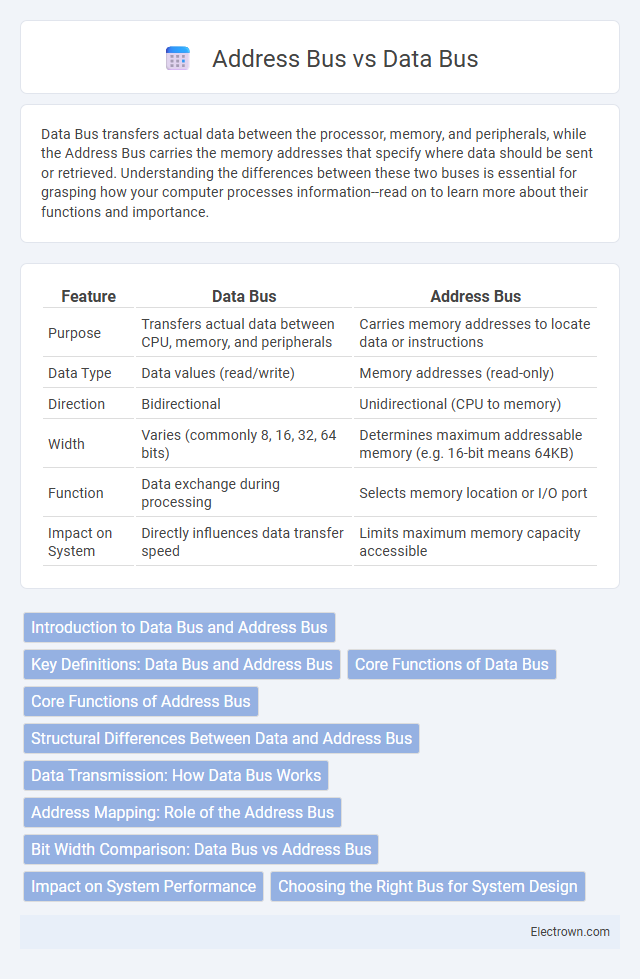Data Bus transfers actual data between the processor, memory, and peripherals, while the Address Bus carries the memory addresses that specify where data should be sent or retrieved. Understanding the differences between these two buses is essential for grasping how your computer processes information--read on to learn more about their functions and importance.
Table of Comparison
| Feature | Data Bus | Address Bus |
|---|---|---|
| Purpose | Transfers actual data between CPU, memory, and peripherals | Carries memory addresses to locate data or instructions |
| Data Type | Data values (read/write) | Memory addresses (read-only) |
| Direction | Bidirectional | Unidirectional (CPU to memory) |
| Width | Varies (commonly 8, 16, 32, 64 bits) | Determines maximum addressable memory (e.g. 16-bit means 64KB) |
| Function | Data exchange during processing | Selects memory location or I/O port |
| Impact on System | Directly influences data transfer speed | Limits maximum memory capacity accessible |
Introduction to Data Bus and Address Bus
The Data Bus transfers actual data between the processor, memory, and peripherals, determining the amount of information that can be handled simultaneously. The Address Bus carries memory addresses, enabling the processor to locate specific data in memory by specifying address locations. Your system's performance depends on the width of these buses, influencing data transfer rates and memory access efficiency.
Key Definitions: Data Bus and Address Bus
The data bus is a communication pathway that transfers actual data between the processor, memory, and other hardware components, determining the width and speed of data transmission. The address bus carries the memory addresses of data, directing the processor to the specific location in memory where data is to be read or written, with its width defining the maximum addressable memory space. Understanding the distinction is crucial for optimizing computer architecture performance, as data buses handle payload information while address buses manage location references.
Core Functions of Data Bus
The core function of the data bus is to transfer actual data between the processor, memory, and other peripherals. It enables communication by carrying the binary information that the CPU processes and stores. Understanding the data bus's role helps you grasp how data moves efficiently within a computer system.
Core Functions of Address Bus
The core functions of the address bus involve transmitting memory addresses from the processor to the memory or I/O devices, enabling accurate location selection for data access or storage. It operates as a one-way bus, carrying address signals that specify where data should be read or written, directly influencing the system's memory range and addressing capacity. The width of the address bus determines the maximum addressable memory space, making it integral to the overall system architecture and performance.
Structural Differences Between Data and Address Bus
The data bus consists of multiple lines that carry actual data between the processor, memory, and peripherals, typically bidirectional to support both reading and writing operations. In contrast, the address bus comprises lines dedicated to transferring memory addresses and is usually unidirectional, sending the address from the processor to memory or I/O devices. Structurally, the address bus width determines the maximum addressable memory space, while the data bus width affects the volume of data transferred simultaneously.
Data Transmission: How Data Bus Works
The data bus transfers actual data between the processor, memory, and peripherals by carrying binary information in parallel lines, allowing simultaneous bit transmission for efficient communication. Its width, measured in bits (such as 8, 16, 32, or 64 bits), directly influences the volume of data transmitted per clock cycle, impacting overall system performance. Understanding how your data bus operates helps optimize data flow and improves the speed of data access and processing within your computer system.
Address Mapping: Role of the Address Bus
The address bus plays a crucial role in address mapping by transmitting unique memory addresses from the CPU to the memory or peripheral devices, enabling precise data retrieval and storage. Unlike the data bus that carries the actual data, the address bus specifies the exact location in memory where data should be read or written. Efficient address mapping relies on the width of the address bus, which determines the maximum addressable memory space within a computer system.
Bit Width Comparison: Data Bus vs Address Bus
The data bus typically has a bit width ranging from 8 to 64 bits, allowing it to transfer multiple bits of data simultaneously between the CPU, memory, and peripherals. The address bus's bit width is generally narrower, often between 16 and 32 bits, and determines the maximum addressable memory; for example, a 32-bit address bus can address up to 4 GB of memory. Due to their different functions--data transfer versus memory addressing--their bit widths are optimized for throughput and memory capacity respectively.
Impact on System Performance
The width of the data bus directly influences the amount of data the CPU can process and transfer simultaneously, improving system throughput and reducing bottlenecks. A wider address bus expands the maximum addressable memory, enabling faster access to larger memory spaces and enhancing multitasking capabilities. Efficient coordination between data bus and address bus widths is critical for optimizing overall system performance and ensuring balanced processing speed and memory access.
Choosing the Right Bus for System Design
Choosing the right bus for system design depends on the specific requirements of data transfer and memory access. A Data Bus transmits actual data between components, while an Address Bus carries memory addresses to locate data storage locations. Understanding your system's need for bandwidth, speed, and complexity helps determine whether prioritizing a wider Data Bus or a larger Address Bus optimizes overall performance.
Data Bus vs Address Bus Infographic

 electrown.com
electrown.com